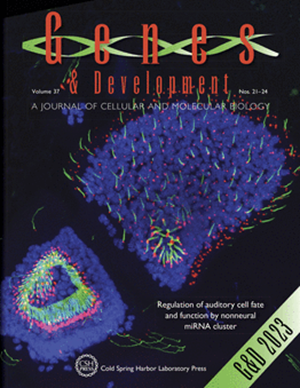NOTCH1 S2513 is critical for the regulation of NICD levels impacting the segmentation clock in hiPSC-derived PSM cells and somitoids
IF 7.7
1区 生物学
Q1 CELL BIOLOGY
引用次数: 0
Abstract
The segmentation clock is a molecular oscillator that regulates the timing of somite formation in the developing vertebrate embryo. NOTCH signaling is one of the key pathways required for proper functioning of the segmentation clock. Aberrant NOTCH signaling results in developmental abnormalities such as congenital scoliosis as well as diseases such as T-cell acute lymphoblastic lymphoma (T-ALL). In this study, we analyzed the effects of a mutation detected in T-ALL patients on somitogenesis using human iPSC-derived PSM cells and somitoids. Mutation of NOTCH1 serine 2513 into alanine compromises the interaction of Notch intracellular domain (NICD) with the F-box protein FBXW7 and consequently increases NICD stability and NICD levels in PSM cells. Moreover, the mutation impairs several aspects of clock gene oscillations such as signal intensity, periodicity, directionality of the oscillations, and the ability to sustain oscillations. Furthermore, it restricts the ability of somitoids to polarize, elongate, and form paired segments. The data suggest a mechanism by which post-translational modification of a key segmentation clock component plays a crucial role in vertebrate axis segmentation.NOTCH1 S2513对NICD水平的调控至关重要,影响hipsc衍生的PSM细胞和体质体的分割时钟
分割时钟是调节发育中的脊椎动物胚胎中体形成时间的分子振荡器。NOTCH信号是分割时钟正常工作所需的关键通路之一。异常的NOTCH信号导致发育异常,如先天性脊柱侧凸以及t细胞急性淋巴母细胞淋巴瘤(T-ALL)等疾病。在这项研究中,我们使用人类ipsc衍生的PSM细胞和类体细胞分析了T-ALL患者中检测到的突变对躯体发生的影响。NOTCH1丝氨酸2513突变为丙氨酸破坏了Notch胞内结构域(NICD)与F-box蛋白FBXW7的相互作用,从而增加了PSM细胞中NICD的稳定性和NICD水平。此外,突变损害了时钟基因振荡的几个方面,如信号强度、周期性、振荡的方向性和维持振荡的能力。此外,它还限制了体质体极化、伸长和形成成对片段的能力。这些数据表明,一个关键分割时钟组件的翻译后修饰在脊椎动物轴分割中起着至关重要的作用。
本文章由计算机程序翻译,如有差异,请以英文原文为准。
求助全文
约1分钟内获得全文
求助全文
来源期刊

Genes & development
生物-发育生物学
CiteScore
17.50
自引率
1.90%
发文量
71
审稿时长
3-6 weeks
期刊介绍:
Genes & Development is a research journal published in association with The Genetics Society. It publishes high-quality research papers in the areas of molecular biology, molecular genetics, and related fields. The journal features various research formats including Research papers, short Research Communications, and Resource/Methodology papers.
Genes & Development has gained recognition and is considered as one of the Top Five Research Journals in the field of Molecular Biology and Genetics. It has an impressive Impact Factor of 12.89. The journal is ranked #2 among Developmental Biology research journals, #5 in Genetics and Heredity, and is among the Top 20 in Cell Biology (according to ISI Journal Citation Reports®, 2021).
 求助内容:
求助内容: 应助结果提醒方式:
应助结果提醒方式:


